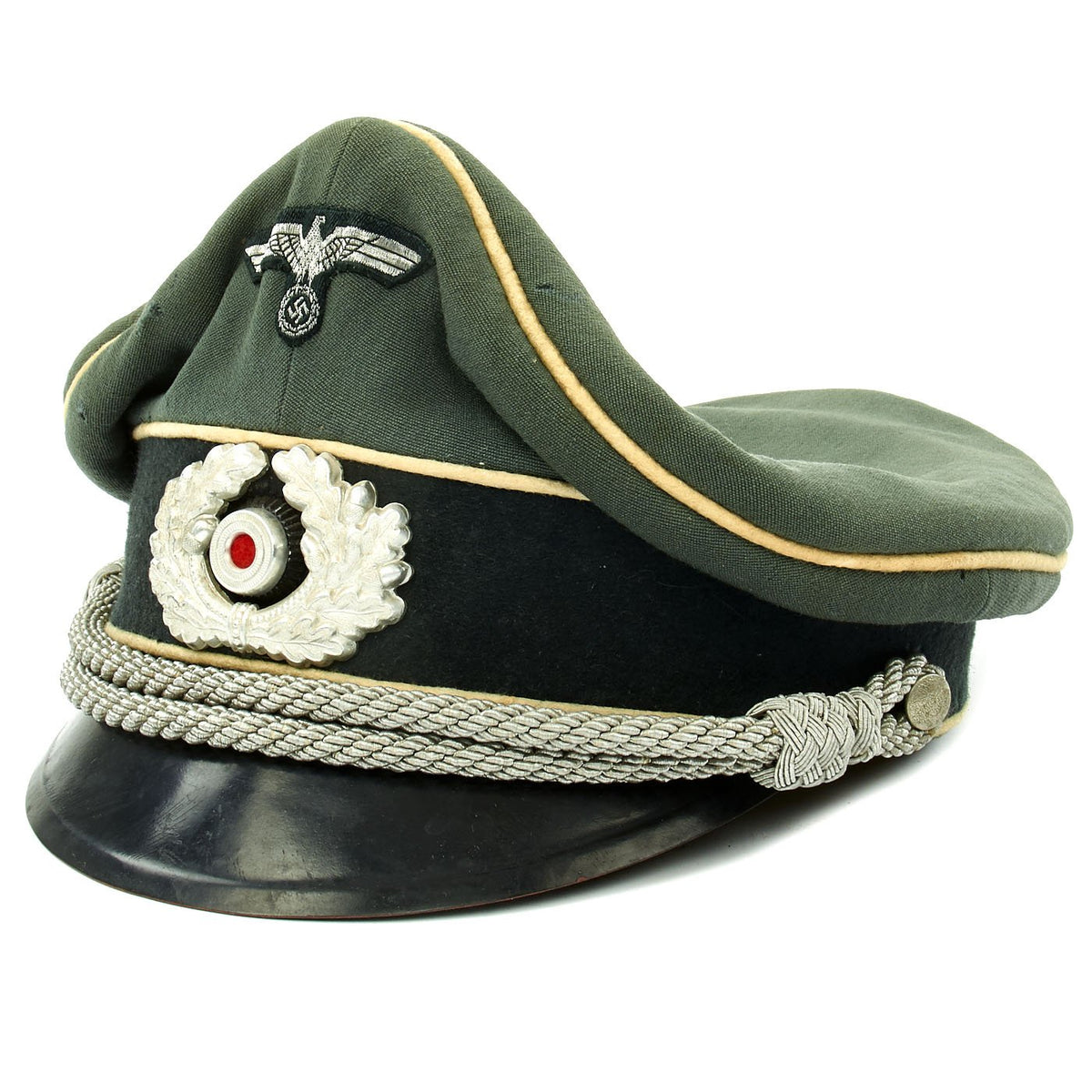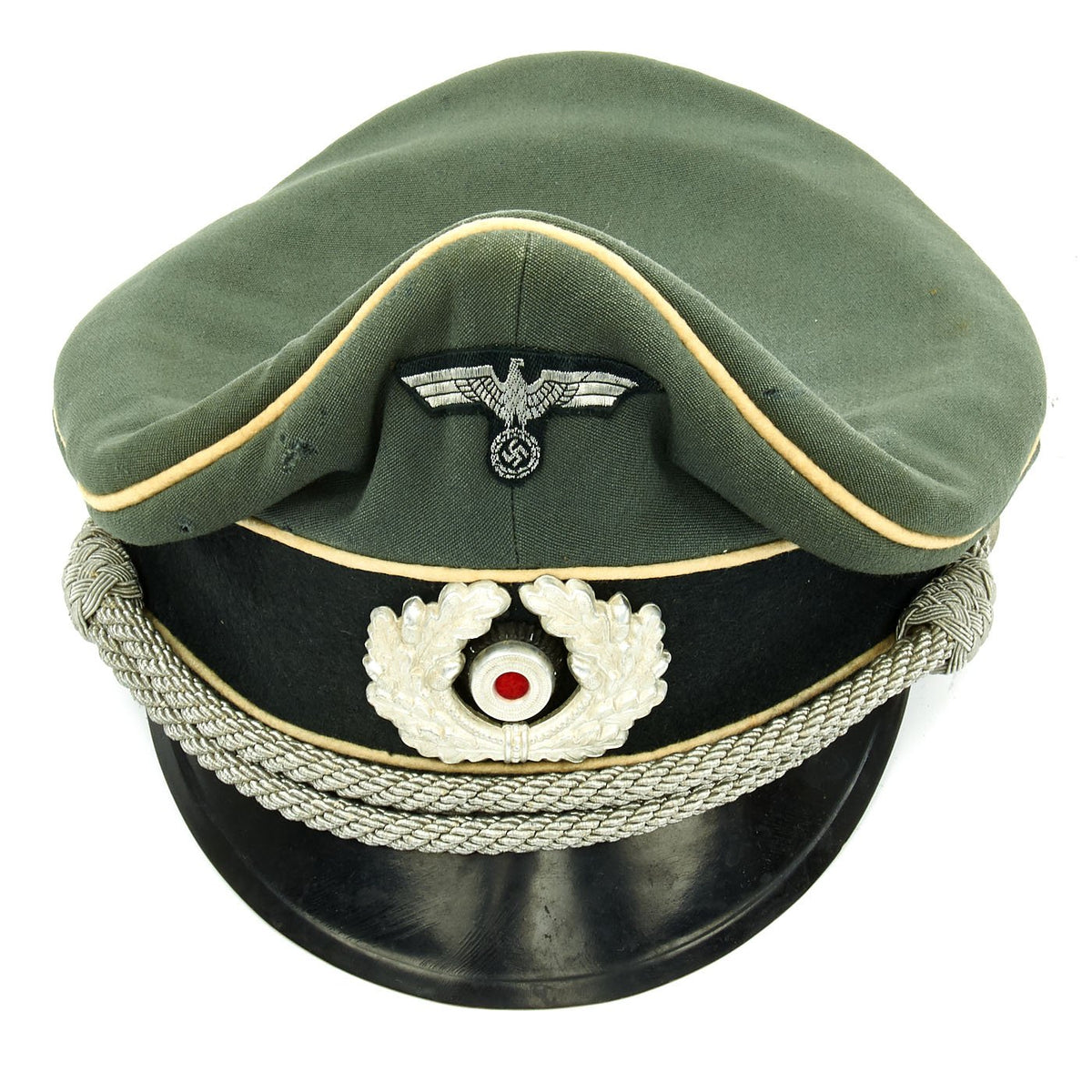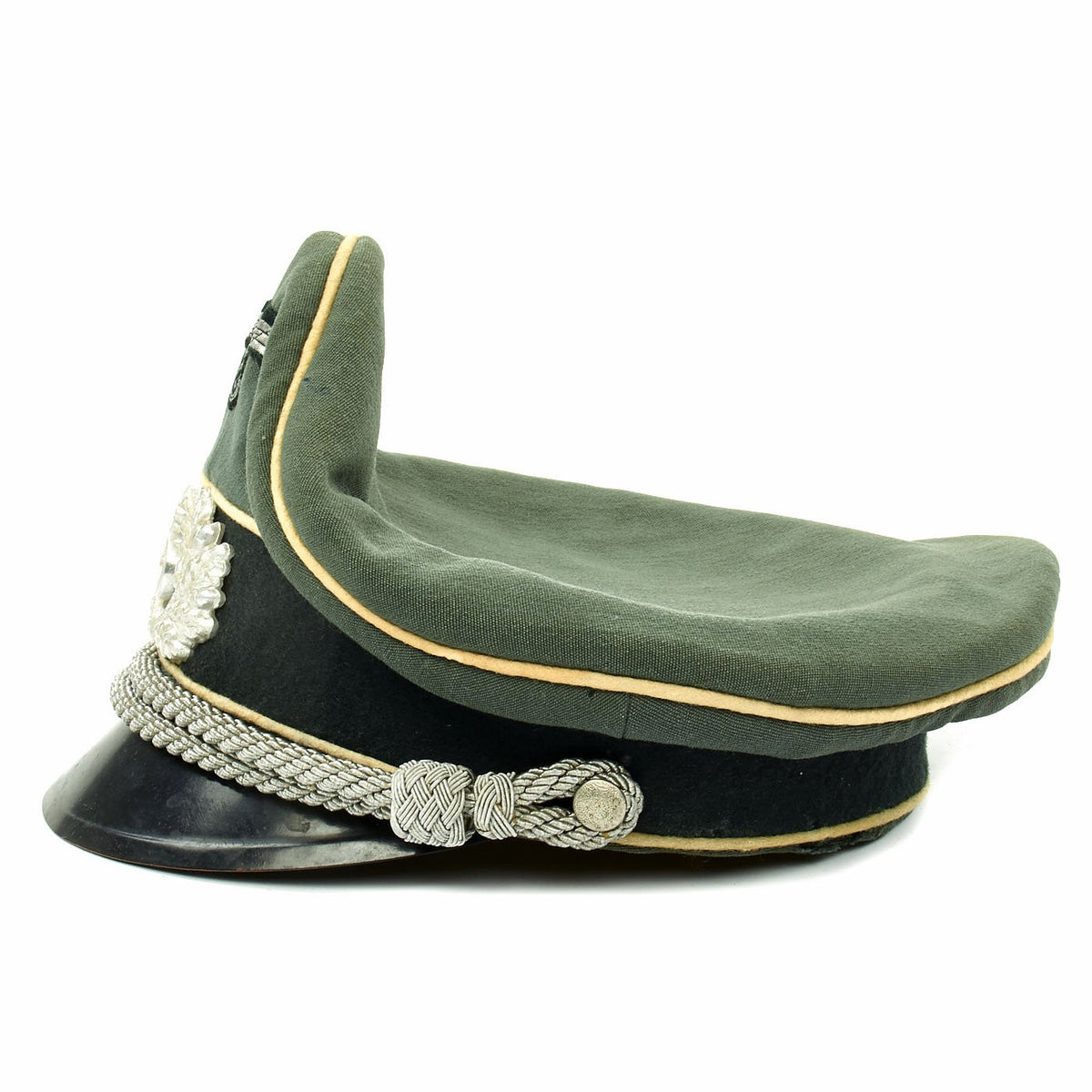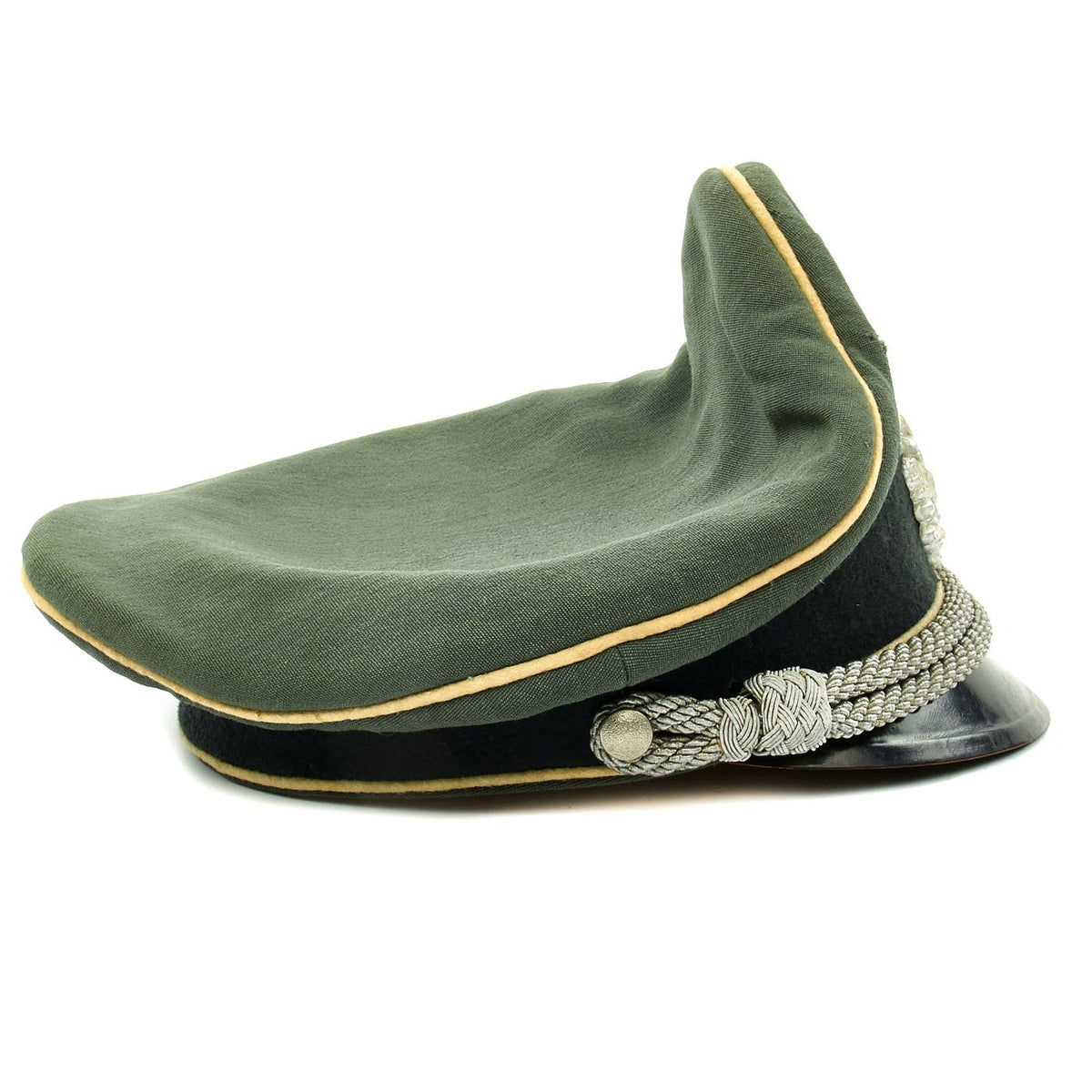Original German WWII Army Heer Officer Visor Crush Cap by Schellenberg with Photo of USGI Wearing Hat Original Items
$ 1.195,00 $ 298,75
Original Item: Only One Available. This is an excellent condition Officer’s Schirmmütze Visor Crush Cap by Schellenberg. This is a high quality manufactured visor hat with a fantastic saddle form shape. Fabricated in Army green gray wool, with wide dark green wool cap band, plus three rows of white wool piping around the circumference. The peak visor crush cap features a BeVo style embroidered eagle along with an aluminum wreath surrounding a cockade with red felt center.
The cap is lined with golden-yellow silk and shows a full-celluloid diamond bearing the Schellenberg trademark logo and reads:
Walter Bunn was a known distributor of Schellenberg caps. Size of this cap is approximately 55cm.
However, the most notable feature of this visor cap is the original 8″ x 10″ photo of the American Veteran that captured the hat and brought it home as a trophy of war. Written in pencil on the reverse of the photo it reads:
100 Infantry Division in WWII in the European Theater:
As soon as the division was prepared for combat, it began moving into the Meurthe-et-Moselle region, and sent its first elements into combat at St. Remy in the Vosges Mountains on 1 November 1944. The division as a whole began the relief of the 45th Infantry Division at Baccarat on 5 November, and assumed control of the sector on 9 November. The attack jumped off on 12 November, and the division drove against the German Winter Line in the Vosges Mountains. The 100th took Bertrichamps and Clairupt, pierced the German line, and seized Raon-l’Étape and Saint-Blaise-Moyenmoutier between 16 and 26 November. Later in November the division moved into the Vosges region,[11] elements assisted in holding the Saverne Gap bridgehead while the bulk of the division went into reserve. The unit was relieved from assignment to VI Corps and transferred to the US XV Corps on 27 November 1944. It then moved into the Moselle region.
In December 1944, the division went on the offensive in the vicinity of Bitche, France. The division occupied the nearby areas of Wingen and Lemberg after fierce fighting on 6–10 December. The division then advanced to Reyersviller, which fell after fighting on 11–13 December. On 14 December, regiments from the 100th started their assault on a minor fortification Freundenburg and Fort Schiesseck, a major defensive work in the region.[ Fort Freundenburg was captured on 17 December by the 100th division’s 398th Infantry Regiment.[ Fort Schiesseck capitulated after three more days of heavy assault by the 100th on 20 December. The division was ordered to halt its attack and to hold defensive positions south of Bitche as part of the Seventh Army during the Battle of the Bulge. Thanks to a stout defense, the men of the 100th later became known as the “Sons of Bitche”. The German counterattacks of 1 and 8–10 January 1945 were repulsed, after heavy fighting at Bitche. After further attacks stalled and the Germans began to withdraw, the sector was generally quiet and the division prepared to resume its offensive east.
On 15 March 1945, the attack jumped off and on 16 March, Bitche fell to the 100th Infantry Division.[9] The unit was then relieved from assignment to XV Corps, and transferred to XXI Corps on 22 March 1945. Taking Neustadt and Ludwigshafen, the division reached the Rhine River on 24 March. On 25 March 1945, the unit was returned from XXI Corps back to VI Corps.[10] On 31 March 1945, the 100th Infantry Division crossed the Rhine and moved south in the wake of the 10th Armored Division and then east across the Neckar River, establishing and enlarging a bridgehead from 4 to 11 April. Heilbronn fell after nine days of house-to-house combat on 12 April and the division resumed its rapid pursuit of the enemy, reaching Stuttgart by 21 April. The 100th was mopping up along the Neckar, southeast of Stuttgart on 23 April, when it was removed from VI Corps and assigned directly to the Seventh United States Army as an Echelon Above Corps Asset. The division was then assigned primarily to patrolling the sector east of Stuttgart. Shifting to Göppingen on 30 April, the Division engaged in occupational duties as the war in Europe came to an end on V-E Day.
The division took 13,351 enemy prisoners of war on its own.[14] Members of the division won three Medals of Honor, seven Distinguished Service Crosses, five Legions of Merit, 492 Silver Star Medals, 23 Soldier’s Medals, 5,156 Bronze Star Medals, and 90 Air Medals. The division itself was awarded three campaign streamers for participation in the campaign.
100th Infantry Division returned to the United States via the Hampton Roads Port of Embarkation on 10 January 1946, and was released from active duty at Camp Patrick Henry, Virginia that day. The division then began the process of demobilization, before inactivating on 26 January.
Fast Shipping with Professional Packaging
Thanks to our longstanding association with UPS FedEx DHL, and other major international carriers, we are able to provide a range of shipping options. Our warehouse staff is expertly trained and will wrap your products according to our exact and precise specifications. Prior to shipping, your goods will be thoroughly examined and securely secured. We ship to thousands clients each day across multiple countries. This shows how we're dedicated to be the largest retailer on the internet. Warehouses and distribution centres can be located throughout Europe as well as the USA.
Note: Orders with more than one item will be assigned a processing date depending on the item.
Before shipping before shipping, we'll conduct a thorough inspection of the items you have ordered. Today, the majority of orders will be delivered within 48 hours. The delivery time will be between 3-7 days.
Returns
The stock is dynamic and we cannot completely manage it because multiple stakeholders are involved, including our factory and warehouse. So the actual stock may alter at any time. It's possible that you may not receive your order once the order has been made.
Our policy is valid for a period of 30 days. If you don't receive the product within 30 days, we are not able to issue a refund or an exchange.
You can only return an item if it is unused and in the same state as the day you received it. You must have the item in its original packaging.
Related products
Uncategorized
Angolan Rebel 1970s era 60mm Inert Display Mortar from Angolan Civil War Original Items
Uncategorized
Uncategorized
Uncategorized
Uncategorized
Uncategorized
Uncategorized
Uncategorized
Armored Burgonet Helmet & Polearm from Scottish Castle Leith Hall Circa 1700 Original Items
Uncategorized
Uncategorized
Uncategorized
Uncategorized
Uncategorized
Uncategorized
Uncategorized
Uncategorized
Uncategorized













































































